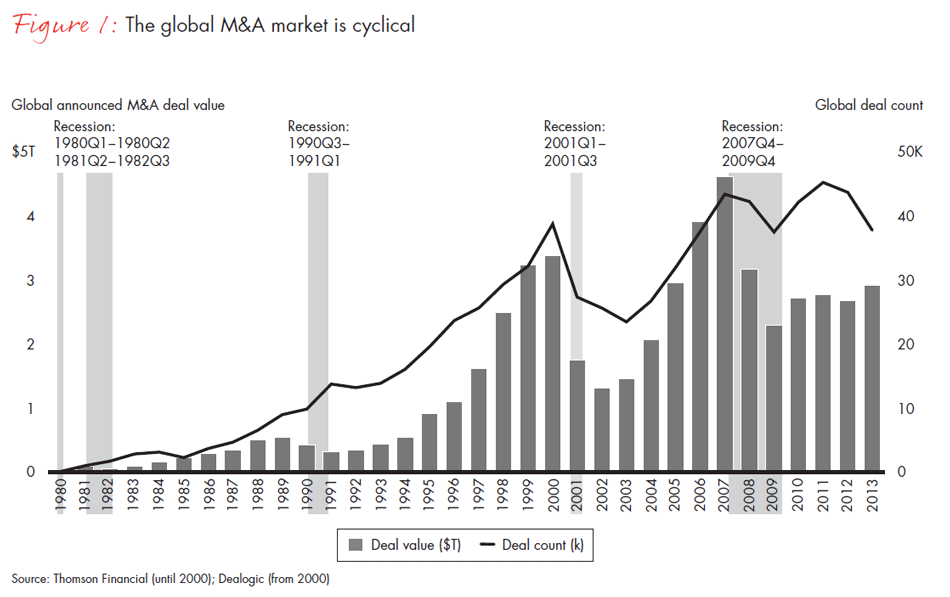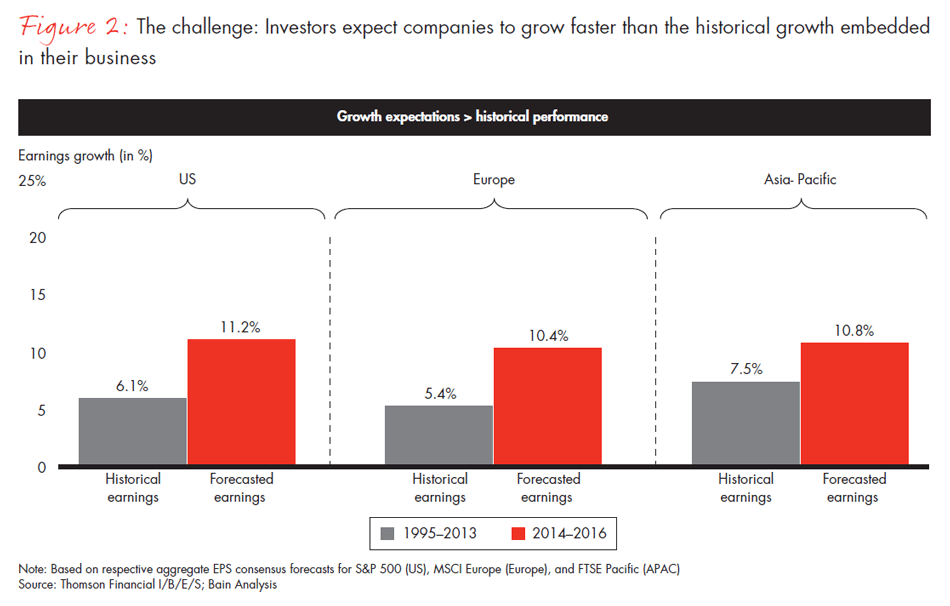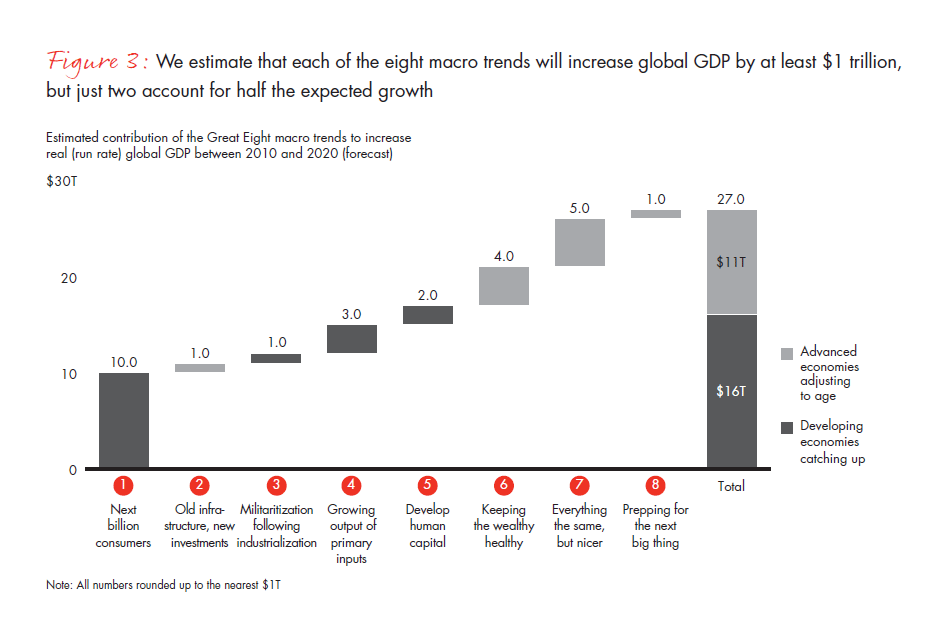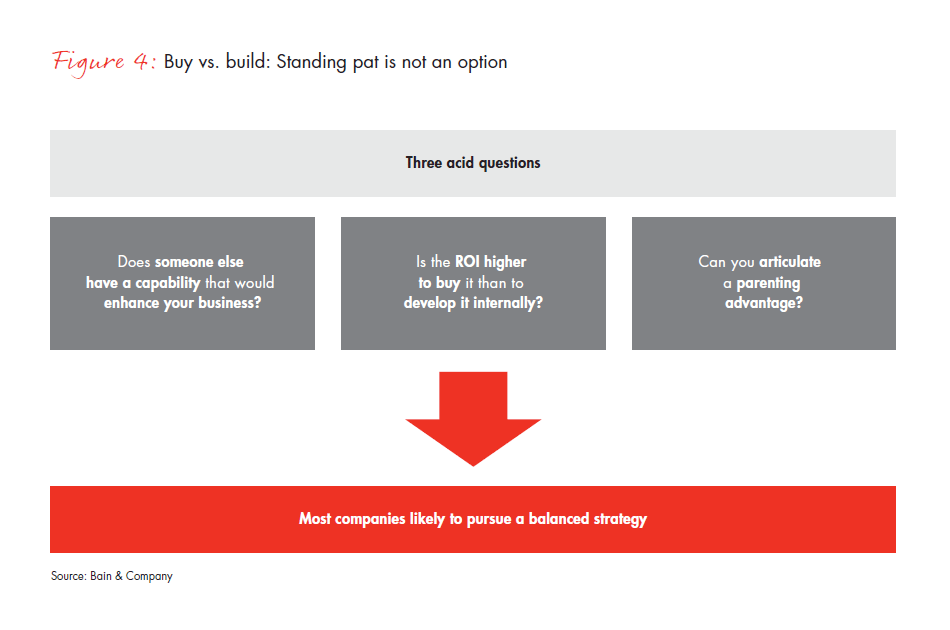Brief
Deal making has always been cyclical, and the last few years have felt like another low point in the cycle. But the historical success of M&A as a growth strategy comes into sharp relief when you look at the data. Bain & Company’s analysis strongly suggests that executives will need to focus even more on inorganic growth to meet the expectations of their investors.
In the first installment of this three-part series on the coming M&A renaissance, “The surprising lessons of the 2000s,” we looked back at the last 11 years of deal activity and examined why it was a very good time for deal makers who followed a repeatable model for acquisitions. The accepted wisdom paints the decade as a period of irrational excess ending in a big crash. Yet companies that were disciplined acquirers came out the biggest winners. Another surprise: Materiality matters. We found the best returns among those companies that invested a significant portion of their market cap in inorganic growth.
In this second part in our series—“What to do with all that cash?”—we look forward. We argue that the confluence of strong corporate balance sheets, a bountiful capital environment, low interest rates and eight great macro trends will combine to make M&A a powerful vehicle for achieving a company’s strategic imperatives. The fuel—abundant capital—will be there to support M&A, and the pressure on executives to find growth will only increase as investors constantly search for higher returns. Some business leaders argue that organic growth is always better than buying growth, but the track record of the 2000s should make executives question this conventional view.
The final part of the series highlights the importance of discipline in a favorable environment for M&A. Deal making is not for everyone. If your core business is weak, the odds that a deal will save your company are slim. But if you have a robust core business, you may be well positioned. All successful M&A starts with great corporate strategy, and M&A is often a means to realize that strategy. Under pressure to grow, many companies will find inorganic growth faster, safer and more reliable than organic investments.
As M&A comes back, some executives will no doubt sit on the sidelines thinking it is safer not to play. Experience suggests that their performance will suffer accordingly. The winners will be those who get in the game—and learn how to play it well.
The world is awash in capital. By Bain’s estimate, about $300 trillion in global financial holdings is available for investment. The time is right to put this money to work, and a lot of it should fund the renaissance in M&A.
Why? One reason is pent-up demand. The slowdown in M&A since 2007 was triggered by the financial crisis, and will reverse itself as the world economy recovers. Each M&A boom tends to outstrip the previous one— both in the number of deals and in the total value of acquisitions (see Figure 1).

This time around, however, three additional factors will turbocharge the deal-making renaissance:
- Financial capital is plentiful and cheap, and will likely remain so. With real interest rates well below historical levels, the pursuit of higher returns will be unrelenting.
- A series of trillion-dollar trends are opening up major new opportunities for growth.
- Many companies are flush with cash and well positioned to capitalize on these opportunities—but organic growth alone is unlikely to produce the returns investors expect.
Together, these factors are likely to push deal making to record levels. Let’s look more closely at the economic environment and the reasons for our belief in an M&A renaissance.
A world awash in capital
Capital is no longer scarce; it’s superabundant. The $300 trillion in financial holdings is about six times larger than the market value of all publicly traded companies in the world. By the end of the decade, capital held by financial institutions will increase by approximately $100 trillion (measured in 2010 prices and exchange rates)—an amount more than six times the US GDP. All that money needs to be put to work.
Capital superabundance produces low interest rates. In the years following the global financial crisis, interest rates in many countries hit new lows, with real rates on low-risk investments hovering around zero. We expect rates to remain low for some time, primarily because of supply and demand: Financial assets have grown considerably faster than real output between the early 1990s and today, a trend that has led to a drop of 4 to 5 percentage points in the global average lending rate during this period. Three interrelated factors reinforce that long-term trend:
- Historically, rates remain low after a crisis of the sort that began in 2007. Households and businesses reduce their borrowing. Growth is sluggish. These long-cycle periods of unusually low interest rates can extend for decades. In the Great Depression and more recently in Japan’s Lost Decade, rates remained low for up to 20 years after the initial crisis.
- Central banks around the world are committed to keeping interest rates low for the foreseeable future. The US Federal Reserve Board has said that it will maintain low rates as long as unemployment stays above 6.5% and inflation remains below 2.5%. The European Central Bank and the Bank of Japan are pursuing similar policies. Central banks are not only setting their own rates low; they are also helping to keep market rates down by pumping money into their economies.
- Despite all this money—and contrary to much conventional wisdom—inflationary pressures around the world are likely to remain weak. The reason is that today’s economy is constrained by the slow pace of growth in demand, not by supply. From 1973 to 1981, the most recent period of sustained high inflation, supply constraints in energy and other sectors combined with buoyant demand from the young baby boomer generation led to continuing upward pressure on prices. In the 2010s, supply growth in most sectors is readily available; many industries have significant overcapacity. Yet demand is tepid and is likely to remain so for decades, partly because of long-term trends such as the aging of the population. Given these two factors, producers will find it difficult to pass price increases on to consumers.
Although abundant capital and easy borrowing will probably not feed general inflation, they are almost certain to have one kind of inflationary effect: They will feed the growth of asset bubbles. In a global economy, some assets somewhere are likely to be increasing in price at any given time; it might be metals, agricultural commodities, fuels, farmland, other real estate or indeed nearly any other class of assets. As investors around the world pour their money into these assets their prices rise still higher, and the stage is set for a classic bubble. In the environment we have described, the bubbles will likely last longer and grow bigger before they inevitably burst.
High investor expectations
Capital is superabundant, interest rates are correspondingly low, demand is muted and growth sluggish. Does all this mean that investors expect only modest returns?
Not quite. The data indicates that investors expect companies to grow considerably faster than their historical growth rates. In the US, where this growth gap is most pronounced, companies increased their earnings at an average annual rate of 6% in the period from 1995 through 2013 (see Figure 2). Yearly growth in nominal GDP during the period 2012 to 2016 is likely to be much the same as it was then—but investors expect their companies to grow at about 11% a year.

Executives thus find themselves in a challenging situation. Capital is widely available at relatively low cost, including on their own companies’ balance sheets.
Companies with investment-grade ratings often find that they can borrow at a lower cost than many sovereign nations, whose bonds were once thought to be nearly risk-free. Companies in zones with highly valued currencies—Europe, for instance—can take advantage of their currency’s strength to invest overseas at bargain rates. The job is to put all this money to work with the goal of creating alpha—performance that outstrips market indexes. By the same token, sitting on cash can be a high-risk strategy when rivals are repositioning themselves for growth.
Hurdle rates for corporate investments symbolize this challenge. In our experience, many chief financial officers (CFOs) have kept hurdle rates high relative to interest rates in the post-crisis years, explaining that their caution reflects the general risks of an uncertain world and the specific risk that interest rates would return to historically normal levels. But lowering hurdle rates may actually be a more appropriate move for an era of capital superabundance. Lowering them too far is always a danger, but so is leaving them high. A company with high hurdle rates may wind up perpetually meeting its earnings targets while curtailing investment and sacrificing topline growth—not a formula for making shareholders happy over the long term. CFOs face a further challenge as well. Though they are punished by the market for failing to protect against risk, they aren't rewarded for using the balance sheet strategically to strengthen the business—particularly since such an approach wasn’t necessary prior to the global financial crisis.
Macro trends—and the opportunities for growth
Against the backdrop of this business climate, we see eight macro trends in the global economy that open up major new growth opportunities (see Figure 3). We won’t discuss them in detail here—for a full account, see our report, “The great eight: Trillion-dollar growth trends to 2020.” This brief summary, with the “great eight” shown in italics, indicates the potential for growth.

Consumers. By 2020, the next billion consumers in developing nations will join the ranks of the global middle class, earning more than $5,000 a year. Their purchasing power and preferences will be different from those of middle-class consumers in developed nations, but taken as a group they will add an additional $10 trillion to world GDP by 2020. Companies targeting this group need lower cost structures than in use today—and they can’t assume these consumers will move up the price ladder over time.
Consumers in developed countries will be looking for more of what they have enjoyed in the recent past— everything the same but nicer, better and more carefully tailored to their tastes and lifestyles. Along with technological innovations such as tablet computers will come “soft” innovations, such as the ability to deliver a new outfit to an online shopper’s doorstep the same day she orders it. Soft innovations enhance and stimulate consumption by providing extra value that buyers are willing to pay for. They are likely to transform whole categories of consumer goods and services, from fashion to food.
Government and infrastructure. In developed nations, old infrastructure, new investments will translate into a surge of spending by governments on replacements and upgrades of physical infrastructure. With public funds limited, some of these jobs will be undertaken by public-private partnerships, and are likely to contribute about $1 trillion to world GDP. Meanwhile, militarization following industrialization—arms buildup in the developing world—presents an opportunity for arms developers but, more important, a risk to global business. China has an overarching interest in protecting its supply chain, but the supply chains are shared by Japan and (to some extent) by India. The risk of an attenuated supply chain, in turn, puts a premium on building capacity closer to end markets, which leads many companies to consider moving operations back to the US and Europe.
Developing nations face the challenge of developing human capital, and their social infrastructure is likely to require even more investment than their physical infrastructure. The combination of broadening access to education, building effective healthcare delivery systems and strengthening the social safety net will add as much as $2 trillion to world GDP. Additionally, rapid growth in these emerging markets has created a global shortage of management talent that is only going to get worse. In developed nations, meanwhile, new healthcare spending—keeping the wealthy healthy—will likely add $4 trillion to GDP.
The next big thing—and the resources to support all of these trends. Major innovations come in waves, and five potential platform technologies—nanotechnology, genomics, artificial intelligence, robotics and ubiquitous connectivity—show promise of flowering over the next decade. New technologies tend to reinforce one another. Prepping for the next big thing should open up unexpected opportunities in both consumer goods and industrial processes. When the next big things arrive, they are likely to accelerate growth.
All of these trends require growing output of primary inputs, meaning large investments in basic resources such as food, water, energy and ores. Growing demand will stimulate new investment, but will also lead to spot shortages and price volatility. All told, the primary goods sector will likely add $3 trillion to global GDP.
Why M&A?
For leadership teams, one vital challenge is how to best position their businesses to take advantage of these emerging trends. A strategy focused on organic growth alone is unlikely to deliver the expanded capabilities or market penetration they need. Most companies will have to rely on a balanced strategy, pursuing M&A as well. In many cases it is faster and safer to buy an asset than to invest in building your own (see Figure 4).

Three essential questions can help companies determine when buying rather than building makes sense for them:
- Does someone else have a capability that would enhance your business? There are many different kinds of capabilities—technologies, sales channels, operations in particular geographic areas and so forth. If no one else has the capabilities you need to strengthen or adapt your business, you obviously have to grow them yourself. If the capabilities are available, they may be candidates for acquisition. When Comcast, the American cable TV giant, concluded that it needed content to feed its cable franchises, it bought NBC/Universal and the libraries, production and news infrastructure that came with it.
- Is the risk-adjusted rate of return higher if you buy the capability than if you build it internally? Every acquisition carries risks, but every investment in organic growth also carries risks. The challenge for companies’ financial teams is to create apples-to-apples comparisons for expected returns on investments in organic vs. inorganic growth, factoring in the risks on both sides as accurately as possible. When Italian tire maker Pirelli wanted to enter Russia, it concluded that buying a “brownfield” plant and existing business was better than starting from scratch in a notoriously difficult market for launching a business.
- Do you have a “parenting advantage” in managing the capability? Capabilities don’t exist in a vacuum; they exist in organizations. If your organization is better than anybody else at managing a particular capability—perhaps because of your experience with similar ones—you have a built-in advantage over other potential acquirers. Nestlé, the global leader in infant nutrition, was probably the best possible corporate parent to buy Pfizer’s largely orphaned baby formula business.
Of course, this analysis raises an obvious question. If the environment for M&A is already favorable, why has the pace of deal making been so slow during the recovery from the financial crisis? The chief reason in our view is that sellers are holding back. Potential divestors expect business valuations to increase, and so are inclined to hold on to their assets for the time being. But this is likely to change quickly, once sellers come to see their assets as fully valued or once they realize that they will be rewarded for prudent divestitures. When a company is planning divestitures, attempts to time the market should take a back seat to a rigorous assessment of strategy and the highest-yielding investment priorities, a topic we examine more fully in our article “How the best divest,” published by Harvard Business Review in 2008.
The risks
While the environment for M&A will be generally favorable, would-be acquirers have to watch for a number of macroeconomic risks and manage them accordingly. Five are likely to be significant:
- The prevalence of asset bubbles. As we suggested earlier, the number, size and duration of asset bubbles are all likely to increase. Asset bubbles carry three unmistakable signs: a kernel of real opportunity followed by a rapid run-up in prices, valuations unsupported by underlying cash flows and plenty of explanations that purport to show why “things are different this time.” Part of the discipline of any kind of investing is recognizing the warning signs of a bubble. Like avoiding a rip current by swimming parallel to shore, investors have to steer clear rather than trying to fight or ride the deadly tide.
Bubble detection capabilities are important for every company, not just financial intermediaries and investors. The key is to separate out the factors that drive long-term, sustainable growth from speculative shorter-term influences. To do so, executives need deep knowledge of a business’s fundamentals and its interaction with the broader environment. In the recent US housing bubble, for instance, homebuilders could have examined the demographics of the population and trends in income growth. The widening gulf between income and population growth (on the one hand) and the market value of housing (on the other) was a clear signal of an emerging bubble. The bigger, broader and longer-lasting bubbles produced by abundant capital may lead companies to assume that a twoyear or even three-year trend is real and permanent. Businesses may then deploy real resources only to have the bottom fall out before they can gracefully exit their position. The effects can quickly become catastrophic.
- Currency volatility. Currency is one of the largest traded commodities in the world. It is subject both to massive intervention by governments and to long-term structural forces that alter its value relative to other currencies and to underlying baskets of goods and services. Every company’s deal modeling should reflect both upside and downside currency scenarios.
- Captured cash. Though the world is awash in capital, a large fraction may not be accessible to home-market companies because of tax policies and currency controls. This can lead to the odd phenomenon of companies with significant cash on the balance sheet needing to borrow to complete transactions or even to pay dividends. JPMorgan Chase, which studied 600 US companies that break out how much cash they hold overseas, notes that foreign holdings represent about 60% of these companies’ cash, much of it in US dollars. Some companies have resorted to setting up listed overseas affiliates to better use the captured cash and tap into local liquidity. According to the same bank, 50% of recent listings in Hong Kong have been by overseas companies.
- China as an exporter of capital. The Chinese government has deliberately pursued policies that keep domestic consumption relatively low and investment levels high. Because of these policies, China will likely have excess capital for both domestic and international investment; indeed, Bain’s Macro Trends Group expects it to contribute an estimated $87 trillion to the growth in financial assets by 2020, more than any other single country. This will put upward pressure on domestic Chinese assets available for sale to foreign investors. It may also contribute to a variety of asset bubbles.
- Increased supply chain risk. The world has grown comfortable—possibly too comfortable—with the decades-long trend toward ever-longer supply chains. In the coming years, a variety of forces may combine to reverse the trend. On the macroeconomic front, productivity is increasing and the labor-cost gap between developed and developing nations is shrinking. On the microeconomic side, companies are beginning to realize better returns from locating production closer to consumer markets. Add in the increased militarization of some Asian nations, and you have several forces that may send the supply chain trend in the opposite direction. The risk for would-be acquirers, of course, is buying production assets in faraway places just as the world is moving in the opposite direction.
While M&A is a good strategy for most companies, it is not easy or simple. The companies best positioned to work through the issues described above in a disciplined manner are those with deep experience in M&A. In Part III of this series, we return to our theme of the virtues of a repeatable M&A model for success, which we will lay out in further detail.
David Harding is a partner with Bain & Company in Boston and co-leader of Bain’s Global M&A practice. Karen Harris is director of the Bain Macro Trends Group and is based in New York. Richard Jackson is a partner in London and leader of Bain’s M&A practice in EMEA. Satish Shankar is a Bain partner in Singapore and leader of the firm’s Asia-Pacific M&A practice.



